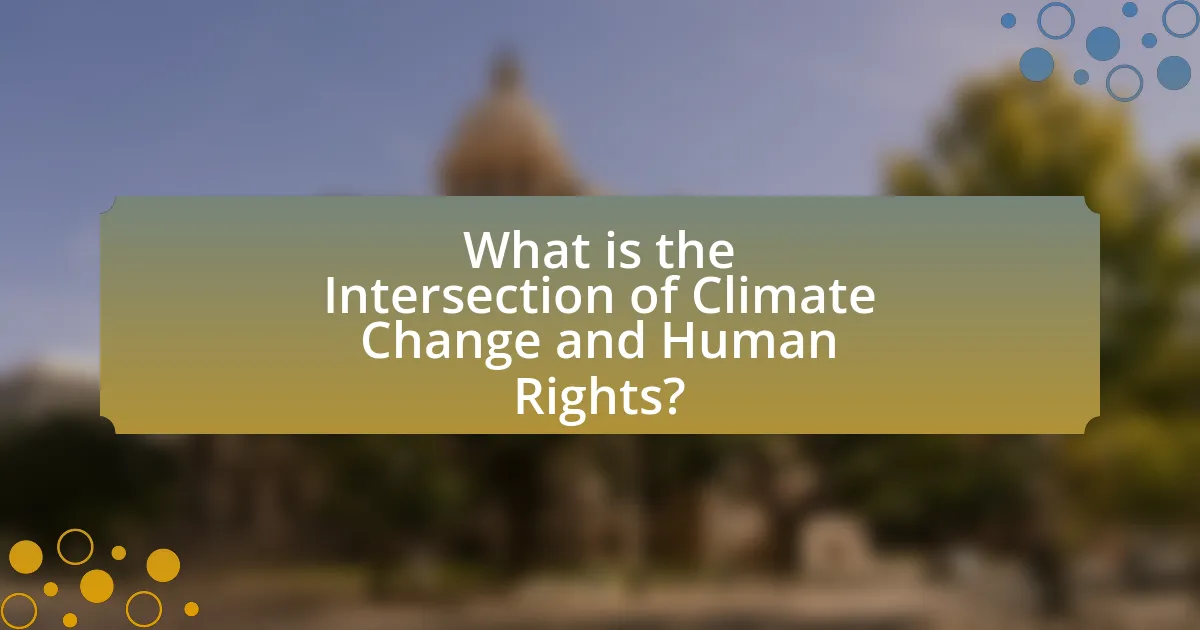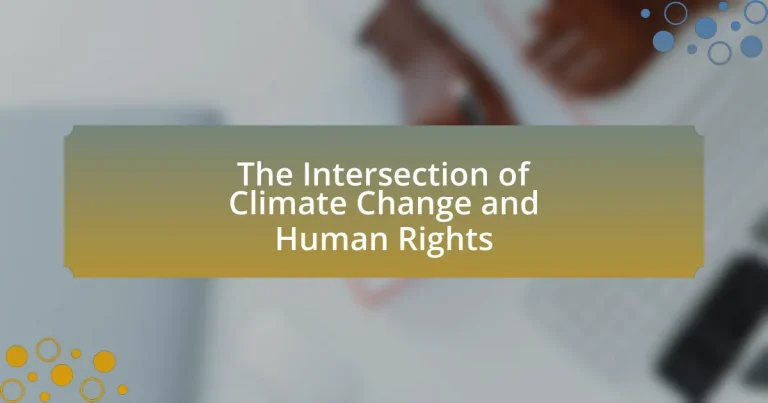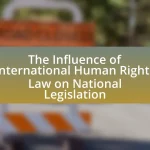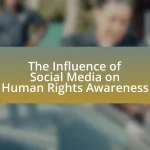The article examines the intersection of climate change and human rights, highlighting how climate change threatens fundamental rights such as life, health, food, water, and housing, particularly for vulnerable populations. It discusses the global impact of climate change on human rights, the specific rights affected, and the disproportionate effects on marginalized communities. The article emphasizes the importance of integrating human rights considerations into climate policies to ensure equitable protection and support, while also addressing the challenges activists face in advocating for these rights. Additionally, it explores the role of international human rights laws, the need for global cooperation, and practical steps individuals can take to support vulnerable populations affected by climate change.

What is the Intersection of Climate Change and Human Rights?
The intersection of climate change and human rights refers to the ways in which climate change impacts the fundamental rights of individuals and communities. Climate change exacerbates issues such as access to clean water, food security, health, and housing, which are essential human rights. For instance, the United Nations has recognized that climate change poses a significant threat to the realization of human rights, particularly for vulnerable populations, as seen in the 2018 report by the Intergovernmental Panel on Climate Change, which highlights the disproportionate effects on marginalized communities. This connection underscores the necessity for climate action to be integrated with human rights protections to ensure that all individuals can enjoy their rights in the face of environmental changes.
How does climate change impact human rights globally?
Climate change significantly impacts human rights globally by exacerbating vulnerabilities and threatening the fundamental rights to life, health, food, water, and housing. For instance, rising sea levels and extreme weather events displace populations, violating their right to a safe living environment. According to the Intergovernmental Panel on Climate Change (IPCC), climate-related disasters have increased in frequency and intensity, leading to millions being displaced annually, which directly infringes on their rights to security and stability. Additionally, the World Health Organization (WHO) reports that climate change contributes to health risks, including heat-related illnesses and the spread of infectious diseases, undermining the right to health. These examples illustrate how climate change not only poses environmental challenges but also fundamentally threatens the realization of human rights across the globe.
What specific human rights are affected by climate change?
Climate change specifically affects the right to life, the right to health, the right to food, the right to water, and the right to housing. These rights are compromised due to increased natural disasters, rising sea levels, and extreme weather events, which threaten livelihoods and access to essential resources. For instance, the United Nations has reported that climate change exacerbates food insecurity, impacting the right to food for millions globally. Additionally, the World Health Organization has highlighted that climate change contributes to health risks, thereby infringing on the right to health.
How do vulnerable populations experience these impacts?
Vulnerable populations experience the impacts of climate change through increased exposure to environmental hazards, economic instability, and health risks. For instance, low-income communities often reside in areas more susceptible to flooding and extreme weather events, leading to displacement and loss of property. Additionally, marginalized groups, such as indigenous peoples, face threats to their traditional livelihoods and cultural practices due to changing ecosystems. According to the Intergovernmental Panel on Climate Change (IPCC), these populations are disproportionately affected, with limited resources to adapt or recover from climate-related disasters, exacerbating existing inequalities.
Why is it important to address human rights in climate change discussions?
Addressing human rights in climate change discussions is crucial because climate change disproportionately affects vulnerable populations, leading to violations of their rights. For instance, the United Nations has reported that marginalized communities, including indigenous peoples and low-income groups, face greater risks from climate impacts such as extreme weather, food insecurity, and displacement. These groups often lack the resources to adapt or recover, making it essential to integrate human rights considerations into climate policies to ensure equitable protection and support. Furthermore, the Paris Agreement emphasizes the importance of protecting human rights in the context of climate action, highlighting the global consensus on this issue.
What role do international human rights laws play in climate action?
International human rights laws play a crucial role in climate action by establishing the legal framework that protects individuals and communities from the adverse effects of climate change. These laws, such as the Universal Declaration of Human Rights and the International Covenant on Civil and Political Rights, affirm the right to life, health, and a healthy environment, thereby obligating states to take action against climate-related harms. For instance, the UN Human Rights Council has recognized that climate change poses a significant threat to the enjoyment of human rights, emphasizing the need for states to mitigate its impacts and adapt to its consequences. This legal recognition compels governments to integrate human rights considerations into their climate policies, ensuring that vulnerable populations receive protection and support in the face of climate challenges.
How can integrating human rights into climate policies enhance effectiveness?
Integrating human rights into climate policies enhances effectiveness by ensuring that the needs and voices of vulnerable populations are prioritized in climate action. This approach fosters inclusivity, leading to more equitable and sustainable solutions that address both environmental and social justice. For instance, the United Nations Framework Convention on Climate Change emphasizes the importance of human rights in achieving climate goals, as neglecting these rights can exacerbate inequalities and hinder effective implementation. By aligning climate policies with human rights standards, governments can create frameworks that not only mitigate climate change but also protect the rights of affected communities, ultimately resulting in more robust and comprehensive climate strategies.

What are the key challenges at the intersection of climate change and human rights?
The key challenges at the intersection of climate change and human rights include the displacement of populations, increased vulnerability of marginalized communities, and the erosion of rights related to health, food, and water security. Climate change leads to extreme weather events, rising sea levels, and resource scarcity, which disproportionately affect low-income and marginalized groups, often resulting in forced migration and loss of livelihoods. According to the United Nations Human Rights Council, climate change poses a significant threat to the realization of human rights, particularly for those already facing social, economic, and environmental injustices.
What obstacles do activists face in advocating for human rights in climate policies?
Activists face significant obstacles in advocating for human rights in climate policies, primarily due to political resistance, lack of funding, and insufficient public awareness. Political resistance often manifests in the form of government pushback against proposed policies that prioritize human rights alongside climate action, as seen in countries where fossil fuel interests dominate political agendas. Lack of funding limits the capacity of activists to mobilize resources for campaigns and outreach, which is critical for raising awareness and influencing policy. Additionally, insufficient public awareness about the link between climate change and human rights undermines support for activist initiatives, making it challenging to build a broad coalition for change. These factors collectively hinder the effectiveness of advocacy efforts aimed at integrating human rights into climate policies.
How do political and economic interests hinder progress?
Political and economic interests hinder progress by prioritizing short-term gains over long-term sustainability, often leading to policies that neglect environmental and social responsibilities. For instance, fossil fuel industries exert significant influence on government policies, resulting in the continuation of practices that contribute to climate change, despite overwhelming scientific evidence of its detrimental effects. This dynamic is evident in the reluctance of many governments to implement stringent environmental regulations, as seen in the United States’ withdrawal from the Paris Agreement in 2017, driven by economic concerns and lobbying from energy sectors. Such actions impede advancements in renewable energy and climate justice, ultimately exacerbating human rights violations linked to environmental degradation.
What are the consequences of neglecting human rights in climate strategies?
Neglecting human rights in climate strategies leads to increased vulnerability and marginalization of affected communities. When climate policies disregard human rights, they often exacerbate existing inequalities, resulting in displacement, loss of livelihoods, and limited access to essential resources such as clean water and food. For instance, the United Nations has reported that marginalized groups, including indigenous peoples and low-income communities, face disproportionate impacts from climate change due to inadequate representation in decision-making processes. This neglect can also lead to social unrest and conflict, as communities struggle to adapt to environmental changes without adequate support or recognition of their rights.
How do different regions experience these challenges?
Different regions experience the challenges of climate change and human rights in distinct ways due to varying socio-economic conditions, environmental vulnerabilities, and governance structures. For instance, low-lying coastal areas, such as Bangladesh, face severe threats from rising sea levels, leading to displacement and loss of livelihoods, which directly impacts human rights related to housing and economic stability. In contrast, regions like Sub-Saharan Africa experience challenges such as drought and food insecurity, exacerbating existing inequalities and limiting access to basic rights like food and water. Furthermore, indigenous populations in the Amazon rainforest confront threats to their land rights and cultural heritage due to deforestation and climate change, highlighting the intersection of environmental degradation and human rights violations. These regional differences underscore the need for tailored approaches to address the unique challenges posed by climate change while safeguarding human rights.
What are the unique human rights issues related to climate change in developing countries?
Unique human rights issues related to climate change in developing countries include increased vulnerability to environmental degradation, displacement due to extreme weather events, and threats to food and water security. Developing countries often lack the resources to adapt to climate impacts, leading to violations of the right to life, health, and adequate living standards. For instance, the United Nations reports that climate change disproportionately affects marginalized communities, exacerbating existing inequalities and limiting access to essential services. Additionally, the loss of livelihoods in sectors like agriculture and fishing due to climate change can lead to economic instability and increased poverty, further infringing on human rights.
How do industrialized nations contribute to human rights violations through climate policies?
Industrialized nations contribute to human rights violations through climate policies by prioritizing economic growth and emissions reduction over the rights and livelihoods of vulnerable populations. For instance, policies that promote large-scale renewable energy projects often lead to land dispossession and displacement of indigenous communities, undermining their rights to land and self-determination. A report by the United Nations Special Rapporteur on Human Rights and the Environment highlights that such practices can exacerbate existing inequalities and violate the rights to health, food, and water for marginalized groups. Additionally, industrialized nations’ failure to provide adequate climate financing to developing countries limits their ability to adapt to climate change, further endangering the human rights of those most affected.

What are the potential solutions to bridge the gap between climate change and human rights?
Potential solutions to bridge the gap between climate change and human rights include integrating human rights frameworks into climate policies, ensuring equitable access to resources, and promoting climate justice initiatives. Integrating human rights frameworks into climate policies ensures that the rights of vulnerable populations are protected, as evidenced by the Paris Agreement, which emphasizes the importance of human rights in climate action. Ensuring equitable access to resources addresses disparities faced by marginalized communities, as highlighted in the UN’s Sustainable Development Goals, which advocate for reducing inequalities. Promoting climate justice initiatives, such as community-led adaptation projects, empowers affected populations and aligns with the principles of the Universal Declaration of Human Rights, which asserts the right to a healthy environment.
How can governments incorporate human rights into climate action plans?
Governments can incorporate human rights into climate action plans by ensuring that policies prioritize the protection of vulnerable populations and uphold their rights to health, livelihood, and participation. This can be achieved through inclusive stakeholder engagement processes that allow affected communities to voice their concerns and influence decision-making. For instance, the United Nations Framework Convention on Climate Change emphasizes the importance of integrating human rights into climate policies, highlighting that climate actions should not exacerbate existing inequalities. Additionally, governments can adopt legal frameworks that explicitly recognize the right to a healthy environment, as seen in countries like Costa Rica, which has enshrined environmental rights in its constitution. By aligning climate strategies with human rights obligations, governments can create more equitable and effective responses to climate change.
What best practices exist for integrating human rights in climate legislation?
Best practices for integrating human rights in climate legislation include ensuring participatory governance, protecting vulnerable populations, and aligning climate policies with international human rights standards. Participatory governance involves engaging affected communities in decision-making processes, which enhances accountability and transparency. Protecting vulnerable populations, such as indigenous peoples and low-income communities, is essential to address the disproportionate impacts of climate change on these groups. Aligning climate policies with international human rights standards, such as the Universal Declaration of Human Rights, ensures that climate actions respect and promote fundamental rights. These practices are supported by frameworks like the Paris Agreement, which emphasizes the importance of human rights in climate action.
How can local communities be empowered to advocate for their rights?
Local communities can be empowered to advocate for their rights through education, capacity building, and access to resources. Education equips community members with knowledge about their rights and the legal frameworks that protect them, enabling informed advocacy. Capacity building initiatives, such as training workshops, enhance skills in negotiation, public speaking, and organizing, which are essential for effective advocacy. Access to resources, including funding and legal support, allows communities to mobilize and sustain their advocacy efforts. For instance, the United Nations Development Programme emphasizes the importance of community engagement in climate action, highlighting that informed and organized communities can effectively influence policy decisions that affect their rights and livelihoods.
What role do international organizations play in this intersection?
International organizations play a crucial role in addressing the intersection of climate change and human rights by establishing frameworks that promote accountability and cooperation among nations. These organizations, such as the United Nations, facilitate dialogues that integrate human rights considerations into climate policies, ensuring that vulnerable populations are protected from the adverse effects of climate change. For instance, the UN Human Rights Council has recognized that climate change poses a significant threat to the enjoyment of human rights, leading to initiatives that advocate for the rights of affected communities. Additionally, international organizations provide funding and technical assistance to support countries in implementing climate adaptation strategies that respect human rights, thereby reinforcing the link between environmental sustainability and social justice.
How can global cooperation enhance the protection of human rights in climate initiatives?
Global cooperation can enhance the protection of human rights in climate initiatives by establishing international frameworks that prioritize human rights alongside environmental goals. Collaborative efforts, such as the Paris Agreement, emphasize the need for countries to commit to climate actions that consider the rights of vulnerable populations affected by climate change. For instance, the United Nations Human Rights Council has recognized that climate change poses a significant threat to the enjoyment of human rights, particularly for marginalized communities. By fostering partnerships among nations, NGOs, and civil society, global cooperation can ensure that climate policies are inclusive, equitable, and protective of human rights, thereby promoting accountability and shared responsibility in addressing climate-related challenges.
What frameworks exist for monitoring and enforcing human rights in climate actions?
Several frameworks exist for monitoring and enforcing human rights in climate actions, including the United Nations Framework Convention on Climate Change (UNFCCC), the Paris Agreement, and the Human Rights Council’s resolutions. The UNFCCC provides a platform for countries to address climate change while considering human rights implications, emphasizing the need for equitable climate action. The Paris Agreement, adopted in 2015, explicitly recognizes the importance of human rights in climate policies, urging parties to respect and promote human rights in their climate actions. Additionally, the Human Rights Council has passed resolutions that call for the integration of human rights into climate change strategies, reinforcing the obligation of states to protect human rights in the context of climate change. These frameworks collectively aim to ensure that climate actions do not infringe upon human rights and promote accountability for violations.
What practical steps can individuals take to support human rights in climate change efforts?
Individuals can support human rights in climate change efforts by advocating for policies that prioritize vulnerable communities. Engaging in local and national advocacy campaigns can amplify the voices of those disproportionately affected by climate change, such as low-income populations and indigenous groups. For instance, the United Nations emphasizes that climate change exacerbates existing inequalities, making it crucial for individuals to push for equitable climate policies that protect human rights. Additionally, individuals can educate themselves and others about the human rights implications of climate change, fostering a more informed public discourse. Supporting organizations that focus on climate justice, such as the Climate Justice Alliance, can also help ensure that human rights are integrated into climate action initiatives.
How can awareness and education contribute to this cause?
Awareness and education can significantly contribute to the intersection of climate change and human rights by fostering informed communities that advocate for sustainable practices and policies. Educated individuals are more likely to understand the implications of climate change on vulnerable populations, leading to increased advocacy for human rights protections. For instance, studies show that climate education can enhance public engagement, with a 2019 report from the United Nations indicating that informed citizens are more likely to support climate action initiatives that protect human rights. This connection between awareness and action underscores the importance of integrating climate change education into human rights discourse, ultimately driving systemic change.
What actions can individuals take to advocate for vulnerable populations affected by climate change?
Individuals can advocate for vulnerable populations affected by climate change by engaging in grassroots activism, supporting policy changes, and raising awareness. Grassroots activism includes participating in local climate action groups that focus on the needs of marginalized communities, which often bear the brunt of climate impacts. Supporting policy changes involves lobbying for legislation that protects these populations, such as climate adaptation funding and equitable resource distribution. Raising awareness can be achieved through social media campaigns, educational workshops, and community events that highlight the specific challenges faced by vulnerable groups, such as low-income families and indigenous communities. According to the United Nations, climate change disproportionately affects the most vulnerable, making advocacy essential for promoting human rights and social justice.


